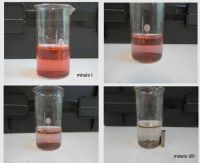Home > Press > Nanostructures to facilitate the process to eliminate organic contaminants in water
 |
| Dissolution process of organic particles through nanoparticles
Nafarroako Unibertsitate Publikoa |
Abstract:
In her PhD thesis, Silvia Larumbe-Abuin has developed nanostructures that assist in the process to decontaminate water. The nanostructures (particles of a microscopic size of between 1 and 100 nanometres) are coated in titanium oxide to which nitrogen has been added. This allows sunlight, rather than ultraviolet radiation, to trigger the process involving the chemical reaction and destruction of contaminants. What is more, thanks to the magnetic nucleus of the particles, once the process has been carried out, they can be retrieved and reused. Silvia Larumbe's thesis is entitled: "Síntesis, caracterización y aplicaciones de nanoestructuras basadas en óxidos de metales de transición" [Synthesis, characterisation and applications of nanostructures based on transition metal oxides].
Nanostructures to facilitate the process to eliminate organic contaminants in water
Usurbil, Spain | Posted on May 12th, 2014The basis of the research conducted is the phenomenon known as photocatalysis: when light affects a substance that acts as a catalyst, the speed of the chemical reaction is increased. In this case, the light activates the titanium oxide and different oxidizing radicals are formed; the latter destroy the organic contaminants in the water, which could be colouring agents, solvents, detergents, etc. As the author of the work explained, "it is a sustainable system that could be used as an alternative to different treatments used traditionally in waste water treatment and, specifically, to eliminate certain organic contaminants".
One of the advantages of this development is the possibility of using sunlight instead of ultraviolet light. "Since nitrogen is added to the coating of the particles, the mechanism that will trigger the process can be sunlight rather than ultraviolet radiation, which means a more accessible, less expensive alternative that poses fewer risks."
The fact that structures of a nanometric size are used also improves photocatalytic capability since the surface of the photocatalyst is greater. Another advantage is the reuse of the catalysing component; since the nanostructures are formed using a magnetic nucleus, they can be retrieved by applying an external magnetic field.
Silvia Larumbe graduated in Chemistry at the University of Navarre, did a Master's in Chemical Science and Technology at the UNED (Open University) and obtained her PhD in the Department of Physics of the NUP/UPNA. She has participated in over twenty or so national and international conferences, is the co-author of twelve research papers, and has participated in various research projects.
References
C. Gómez-Polo, S. Larumbe, J.M. Pastor. (2013). "Room temperature ferromagnetism in non magnetic doped TiO2 nanoparticles". Journal of Applied Physics 113 17B511
####
For more information, please click here
Contacts:
Oihane Lakar
0034-943-363-040
Victoria Alfonso Seminario
Universidad Pública de Navarra
Contact details:
(+34) 948168457
Copyright © Elhuyar Fundazioa
If you have a comment, please Contact us.Issuers of news releases, not 7th Wave, Inc. or Nanotechnology Now, are solely responsible for the accuracy of the content.
| Related News Press |
News and information
![]() Researchers develop molecular qubits that communicate at telecom frequencies October 3rd, 2025
Researchers develop molecular qubits that communicate at telecom frequencies October 3rd, 2025
![]() Next-generation quantum communication October 3rd, 2025
Next-generation quantum communication October 3rd, 2025
![]() "Nanoreactor" cage uses visible light for catalytic and ultra-selective cross-cycloadditions October 3rd, 2025
"Nanoreactor" cage uses visible light for catalytic and ultra-selective cross-cycloadditions October 3rd, 2025
Discoveries
![]() Researchers develop molecular qubits that communicate at telecom frequencies October 3rd, 2025
Researchers develop molecular qubits that communicate at telecom frequencies October 3rd, 2025
![]() Next-generation quantum communication October 3rd, 2025
Next-generation quantum communication October 3rd, 2025
![]() "Nanoreactor" cage uses visible light for catalytic and ultra-selective cross-cycloadditions October 3rd, 2025
"Nanoreactor" cage uses visible light for catalytic and ultra-selective cross-cycloadditions October 3rd, 2025
Announcements
![]() Rice membrane extracts lithium from brines with greater speed, less waste October 3rd, 2025
Rice membrane extracts lithium from brines with greater speed, less waste October 3rd, 2025
![]() Researchers develop molecular qubits that communicate at telecom frequencies October 3rd, 2025
Researchers develop molecular qubits that communicate at telecom frequencies October 3rd, 2025
![]() Next-generation quantum communication October 3rd, 2025
Next-generation quantum communication October 3rd, 2025
![]() "Nanoreactor" cage uses visible light for catalytic and ultra-selective cross-cycloadditions October 3rd, 2025
"Nanoreactor" cage uses visible light for catalytic and ultra-selective cross-cycloadditions October 3rd, 2025
Interviews/Book Reviews/Essays/Reports/Podcasts/Journals/White papers/Posters
![]() Spinel-type sulfide semiconductors to operate the next-generation LEDs and solar cells For solar-cell absorbers and green-LED source October 3rd, 2025
Spinel-type sulfide semiconductors to operate the next-generation LEDs and solar cells For solar-cell absorbers and green-LED source October 3rd, 2025
![]() Rice membrane extracts lithium from brines with greater speed, less waste October 3rd, 2025
Rice membrane extracts lithium from brines with greater speed, less waste October 3rd, 2025
Environment
![]() Researchers unveil a groundbreaking clay-based solution to capture carbon dioxide and combat climate change June 6th, 2025
Researchers unveil a groundbreaking clay-based solution to capture carbon dioxide and combat climate change June 6th, 2025
![]() Onion-like nanoparticles found in aircraft exhaust May 14th, 2025
Onion-like nanoparticles found in aircraft exhaust May 14th, 2025
![]() SMART researchers pioneer first-of-its-kind nanosensor for real-time iron detection in plants February 28th, 2025
SMART researchers pioneer first-of-its-kind nanosensor for real-time iron detection in plants February 28th, 2025
Water
![]() Taking salt out of the water equation October 7th, 2022
Taking salt out of the water equation October 7th, 2022
|
|
||
|
|
||
| The latest news from around the world, FREE | ||
|
|
||
|
|
||
| Premium Products | ||
|
|
||
|
Only the news you want to read!
Learn More |
||
|
|
||
|
Full-service, expert consulting
Learn More |
||
|
|
||








